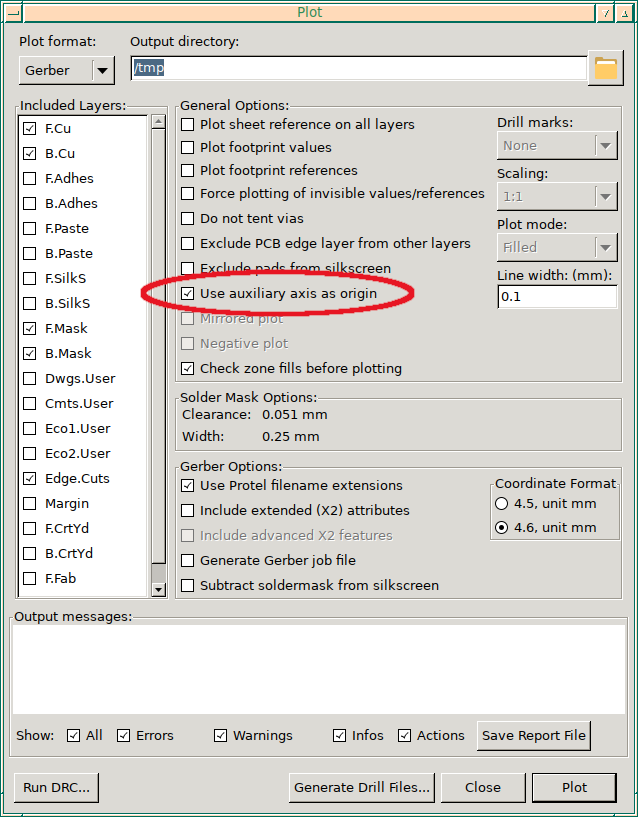

If it does not show already, click Net Classes Editor tab. Click on the Design Rules > Design Rules menu. Generally, you can set the clearance to 0.25 and the minimum track width to 0.25. It is good to start by setting the clearance and the minimum track width to those required by your PCB manufacturer. Set paper size as A4 and title as Tutorial1.ģ.

Click on the Page settings icon on the top toolbar. Begin by entering some schematic information. If you get an error message saying that a *.kicad_pcb file does not exist and asks if you want to create it, just click Yes.Ģ. From the KiCad project manager, click on the Pcbnew icon. An import window will appear, press OK.ġ. Open the *.csv file with LibreOffice Calc or Excel. The file (same name as your project) is located in your project folder.

Select the *.xsl file you want to use, in this case, we select bom2csv.xsl. You add one, by clicking on Add Plugin button. To create a Bill Of Materials (BOM), go to the Eeschema schematic editor and click on the Bill of materials icon on the top toolbar. Check Create ERC file report and press the Run button again to receive more information about the errors.Ģ0. In case of errors or warnings, a small green arrow will appear on the schematic in the position where the error or the warning is located. A report informing you of any errors or warnings such as disconnected wires is generated. Click on the Perform electrical rules check icon on the top toolbar. We will now check our schematic for errors. Then, you can place power and ground symbols, add pins, make connections using labels with the similar steps as above until electronic schematics is completed.ġ9. In the menu, choose Preferences > Component Libraries and click the Add button for Component library files. We are going to add a component from a library that isn't configured in the default project. In general, it is recommended to use a grid of 50.0 mils for the schematic sheet.ġ8. You can easily change the size of the grid by Right-Click > Grid select. You have probably noticed that on the schematic sheet all components are snapped onto a large pitch grid. Reposition the component and left click to drop.ġ7.

Click where you want to place the new duplicated component.ġ6. You can also duplicate a component already on your schematic sheet by hovering over it and pressing the "c" key. Alternatively, you can hover over the component you want to delete and press the "del" key.ġ5. This will remove the component from the schematic. In case you make a mistake and want to delete a component, right click on the component and click Delete Component. The resistor you previously chose is now in your history list, appearing as R. The Component Selection window will appear again.ġ3. To place another resistor, simply click where you want the resistor to appear. Notice how the right-click menu below shows shortcut keys for all available actions.ġ1. Alternatively, the "e" key will take you to the more general Edit window. You can achieve the same result by hovering over the component and pressing the "v" key. Right click in the middle of the component and select Edit Component > Value. You don't need to click on the component to rotate it.ġ0. Hover the mouse over the component R and press the "r" key, the component should rotate. Press the wheel (central) mouse button to pan horizontally and vertically.ĩ. Alternatively, use the mouse wheel to zoom in and zoom out. Click on the magnifier icon to zoom in on the component. Place the component in the schematic sheet by clicking where you want it to be.Ĩ. This will close the Choose Component window. This device heading is the name of the library where the component is located, which is quite a generic and useful library.ħ. You may notice the device heading above the Resistor. A Choose Component window will appear on the screen. Click on the middle of your schematic sheet. Click on the Place Component icon in the right toolbar.Ħ. Save the whole schematic project: File > Save Schematic Project.ĥ. This information will populate the schematic sheet at the bottom right corner. You will see that more information can be entered here if necessary. Set the Page Size as A4 and enter the Title as Tutorial1. Click on the Page Settings icon on the top toolbar. All your project files will be saved here.ģ. KiCad prompts to create a dedicated directory, and click Yes to confirm. The project file will automatically take the extension ".pro". Create a new project: Click File > New Project.
#Egyptian cs go surf map software#
From here you have access to eight stand-alone software tools: Eeschema, Schematic Library Editor, Pcbnew, PCB Footprint Editor, GerbView, Bitmap2Component, PCB Calculator and Pl EditorĢ. You can enter the main window of the KiCad project manager.


 0 kommentar(er)
0 kommentar(er)
